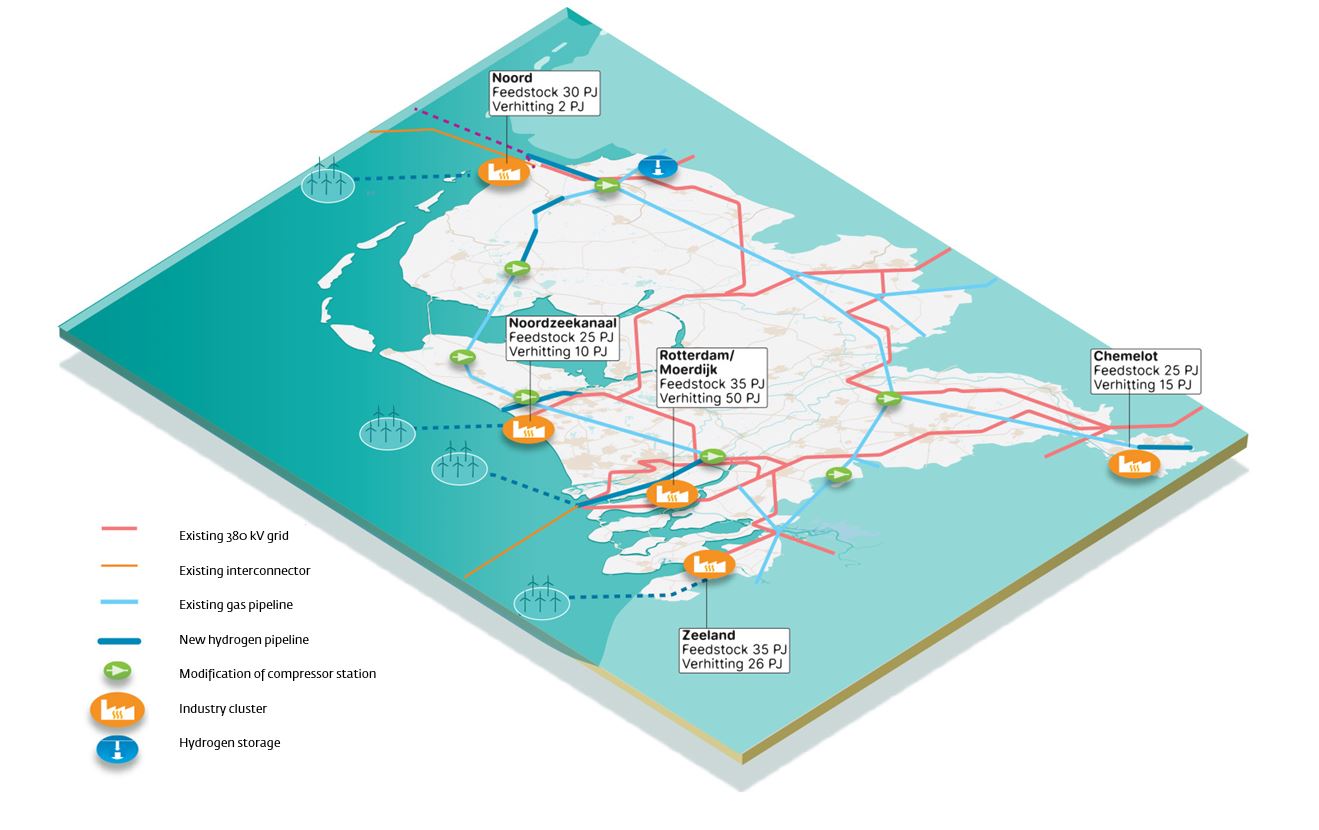A 40 million-euro national hydrogen programme, hydrogen hubs, a green hydrogen coalition and an H2 platform, a special hydrogen envoy, a national hydrogen network, about 200 hydrogen projects and more than 250 companies that are involved. The first element in the periodic table cannot complain about a lack of interest.
Reversal
What is the reason for this increase in initiatives? For years, hydrogen has been an important raw material in the process and chemical industry for the production of ammonia/fertilisers (60%), methanol and for the desulphurisation of oil products. In total, this involves approximately 800,000 tonnes of H2, or 100 PJ per year, which is produced and applied in five regions (see Figure 1). Up until a few years ago, things largely stayed the same. Until the necessary switchover to a fossil-free and circular society created a reversal.
Hydrogen currently is produced from natural gas using a steam reforming process. Only when hydrogen can be produced on a large scale using sustainable electricity (green) or in any event without CO2 emissions (blue) is it really of any help. Because the production of a tonne of hydrogen from natural gas releases as much as nine tonnes of CO2. This is motivating government organisation, environmental organisations, grid operators, the chemical sector, energy companies and scientists to join forces. There is a tremendous amount of innovation,’ says Jörg Gigler Managing Director of the TKI New Gas innovation platform of the Topsector Energy. ‘In 2017, there were roughly one hundred projects in this domain, today this has already doubled.’ There is a great deal of enthusiasm, notes Andreas ten Cate, Program Director System Integration at the Institute for Sustainable Process Technology (ISPT), which initiates and coordinates several electrolysis projects and acts as an arbitrator between parties. ‘It is a good start. The number of parties working on upscaling sustainable hydrogen is limited. This includes companies, such as Engie, Air Liquide, Shell, Nouryon, Yara, OCI Nitrogen, Ørsted, Dow Chemical and Gasunie.’
The strength of hydrogen
How indispensable is hydrogen? ‘Calculations performed by the Netherlands Environmental Assessment Agency (PBL) show that we need to make use of all of the options available to us if we are to be completely CO2 neutral by 2050,’ says Gigler. ‘If we were to exclude even a single option, we are simply not going to make it.’ From the perspective of the chemical industry, hydrogen would appear to be the key to sustainability. The chemical industry as a major consumer of fossil raw materials is diligently searching for alternatives. Electricity/green electricity can be converted into hydrogen and oxygen through water electrolysis. ‘That’s the strength of hydrogen,’ says Gigler. ‘The industry needs molecules. Coupling electricity to molecules is what makes hydrogen interesting. After all, it is impossible to electrify all processes. For some processes, you need hydrogen as a raw material and alternatives for high-temperature heat in the process industry are limited. If you want to implement these processes without natural gas and use renewable sources for this purpose, you basically need to use hydrogen.’ It is therefore not by happenstance that the chemical industry is a leader in developing plans for hydrogen plants. Initially via the blue route and over time via the green route.
Relationship with the biobased economy
But what about the brown route: hydrogen from biomass? How does hydrogen relate to the biobased economy? This is not something that pops right out, but the interfaces and parallels with the biobased economy are interesting. ‘Hydrogen and biomass need each other,’ argues Gigler. Biomass can be an alternative to natural gas for producing high-temperature heat. Just like hydrogen, biomass is currently scarce. However, this is not expected to drastically change for biomass, while for hydrogen the sources in principle are infinite.
Even more crucial is the fact that four molecules are indispensable for chemical processes: C, H, O and N. The industry can produce hydrogen and oxygen with electricity and it can extract nitrogen from the atmosphere, but the story is very different for carbon. Carbon currently is derived from either fossil hydrocarbons or biomass. ‘In theory, you could also extract carbon from the atmosphere, there is enough CO2 out there, but before direct air capture becomes a mature and profitable process will take at least another 15 to 20 years,’ according to Gigler. This leaves biomass as a climate-neutral alternative. Carbon can be extracted from biomass using pyrolysis or gasification. But the chemical industry often needs to add H2 to this bio-mineral oil to be able to manufacture chemical products. This is because biomass carbon chains are very long with proportionately little hydrogen. This is in contrast to natural gas. In other words, in biomass there is a surplus of carbon and a shortage of hydrogen. Biomass also contains a lot of oxygen. To produce plastics such as polypropylene, you need to find ways to get rid of this oxygen. ‘The question remains whether extracting hydrogen from biomass as a raw material for chemical products is the most efficient route,’ says Ten Cate. ‘After all how much effort do you want to put into this?’
Integrated approach
The reverse is true, however. The projects carried out in Eemshaven illustrate the interdependence of hydrogen and biobased raw materials. Over the coming twelve years, the Province of Noord‑Holland intends to invest as much as 2.8 billion euros in hydrogen. The objective is to develop plants for green hydrogen of at least 100 MW and a production site for blue hydrogen of at least 1.2 GW. The Integrated Hydrogen Plan not only involves government organisations, energy producers and grid operators, but also biomass plants, the chemical industry and producers of raw materials, such as Suiker Unie and Avebe.
BioMCN, a subsidiary of OCI Nitrogen, is constructing a biomethanol plant in Eemshaven. Biomethanol is a raw material for the chemical industry and for biofuels. BioMCN uses two ways of producing biomethanol: with biogas from existing biodigesters, which is reprocessed to produce grid quality gas, and through CO2 injection. ‘Our process produces excess hydrogen,’ Søren Jacobsen, CEO of BioMCN, reported at the end of 2018. ‘CO2 is released when biogas is reprocessed. We remove this CO2, transport it to our plant and inject it into our hydrogen to produce biomethanol.’ On the road towards further sustainability, BioMCN is studying three possibilities: first, the construction of its own biodigester; second, the construction of a 20 MW electrolyser together with Gasunie and Nouryon as a means of using sustainably produced hydrogen and CO2 injection for the production of methanol; and finally, the company is studying the gasification of household waste for the purpose of using this syngas in its plant.
The electricity sector is also participating in the hydrogen cluster. The plan calls for the Magnum power plant to run on hydrogen and CO2 will be captured at the Eems power plant. ‘There is a high demand for green hydrogen, so you can never have too many plants for this purpose,’ RWE spokesperson Rob Hageman told broadcaster RTV Noord. ‘A plant for producing super-clean water is located adjacent to the wind farm and the coal-fired power plant. This is because the steam boilers of our coal-fired power plant must continue to run without creating any limestone. When there is no wind, the incineration of biomass in the Eemshaven power plant must generate the energy needed to produce the hydrogen.’ In this cluster, biobased and hydrogen already rely on each other.
Hydrogen and biomass need each other
GZI Next
Emmen too is working on an integrated plan for sustainable electricity, biogas and hydrogen production. In addition to a solar farm, biogas and hydrogen must also be produced on the former premises of a gas purification plant (GZI) in the future. The pipelines and the connection with Gasunie have already been installed. NAM, EMMTEC and Gasunie are investigating whether they can use it for hydrogen and green gas. The EMMTEC property is located four kilometres further away. The industry there is among the top ten natural gas consumers. They want to move away from this; first by making natural gas from abroad suitable for consumption, and later by migrating to hydrogen or biogas. It is therefore a foregone conclusion that the gas line to be installed to the EMMTEC property must also be suitable for carrying hydrogen or green gas. And that in the same trench, a heating pipe will be installed to promote the growth of bacteria in biogas plants. The electricity generated by the solar panels is also meant to be used for producing hydrogen at a later stage.
Gas transport and storage
In speaking about transport and storage, biogas and hydrogen are often mentioned in the same breath. Both are used for storing sustainably generated electricity. This is why Gasunie is one of the pioneers in this area. Gasunie’s Hydrogen Program Manager, René Schutte at a recent H2 platform meeting outlined the important role of green hydrogen and biogas for the industry, transportation and heating. Schutte: ‘The existing gas network can be split up into a network for hydrogen and methane, and has sufficient capacity. There is a great need for sizeable energy storage in the form of hydrogen or biogas as a means for bridging seasons. It is a cheaper solution than the large-scale storage of power in batteries.’ Gasunie expects that a national hydrogen network can be ready by 2030.
Integration
Both hydrogen and biogas are produced locally and therefore enter the system from decentralised locations. This means that additional quality controls at the gate are necessary. There already is experience with biogas in this area. Unlike hydrogen, biogas must first be purified. This is offset by the fact that it is easier to integrate green gas into the existing gas infrastructure, because it perfectly blends in with natural gas. You can also use the existing gas storage facilities. While hydrogen is cleaner, you cannot just feed hydrogen into the gas grid or store it in empty gas fields. Being the smallest element, it much more easily entrenches itself into all kinds of materials. By contrast, H2 can be stored in salt caverns without any problems, which is the intention of the HyStock Project in Zuidwending in the Province of Groningen. Common materials such as PVC, PE and steel in principle are suitable for transporting hydrogen, Although, for example, compressors in the gas grid must be adjusted or replaced. In case of natural gas, the temperature in gas receiving stations drops when pressure is lowered, while in case of hydrogen heat is released.
Different from biogas, current legislation stipulates that hydrogen may not be mixed with natural gas in high proportions: at most 0.5 percent. Gas Transport Services is currently acquiring experience in this area. Since the beginning of July 2019, hydrogen has been flowing through a twelve‑kilometre‑long old Dow Benelux main gas pipeline in Terneuzen to fertiliser producer Yara in Sluiskil. Gigler: ‘Complying with laws and regulations was quite the challenge for this project.’
A great deal of upscaling is still needed and we need to create a stable process
Speed
What are green hydrogen’s greatest challenges? The ambition of the national hydrogen programme is to have an installed electrolyser capacity of 3-4 GW by 2030. Ten Cate: ‘A great deal of upscaling is still needed and we need to create a stable process. As yet, there are not many electrolysers of at least 10 MW. We have to learn how to work with these electrolysers. The technology must become more flexible and efficient. This is a key aspect of the technology programmes.’ Some hydrogen plants are already making use of alkaline water electrolysis, says Gigler. ‘For example, Nouryon is investigating a 20 MW installation. Alkaline water electrolysers are base loading plants that you cannot just switch on and off. To cover the fluctuating supply of solar and wind power, it is best to have a more flexible plant with PEM technology. These can quickly be switched on and off. The largest plant in the Netherlands currently is 1 MW and in Germany a 10 MW plant is being built. Due to its scale, this still requires a great deal of manual work right now.’
Cost Reduction
Furthermore, the cost of electrolysers has to go down. The Hydrogen Coalition, in which 27 parties work together, wants to scale electrolysers up to 1 GW with a cost reduction of 65 percent. According to initial calculations, a 1 GW plant of this type would cost around one billion euros, which means this figure has to be reduced to 350 million euros. Under the ISPT banner, a consortium involving ten parties is designing a 1 GW plant of this type. ‘1 gigawatt corresponds to the capacity of current steam reformers running on natural gas and is consistent with the plans for offshore wind farms,’ Ten Cate explains. ‘The key question is how to produce more H2 in a more efficient manner with an electrolyser. What are your options? It is not going be a single plant with a single large electrolyser, but rather a structure comprising 100 or more 10 MW electrolysers. We are reviewing the local situation in the five regions to assess the possibilities. If it is not yet technically feasible locally, this gives us direction for our technology and testing programme.’
Then there is the market side. Green hydrogen is still too expensive. The key question according to Gigler is whether we will succeed quickly enough to have sufficient solar and wind power at our disposal. The market does not develop all by itself. ‘Can you make money with it?’ is how Ten Cate expresses industry’s concern. ‘The price of green electricity is too high and that of CO2 too low. Government can intervene in this area.’ Add to this a whole series of social, safety and legislative issues that still need to be resolved and it should be clear that we are only just beginning. ‘We should be careful not to underestimate how much time and energy this will take,’ Gigler concludes.
Images: ISPT, TKI, Hydrogen Coalition, Gasunie and Shutterstock






